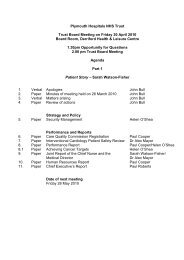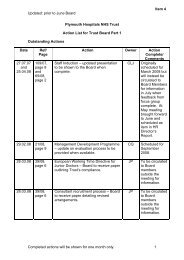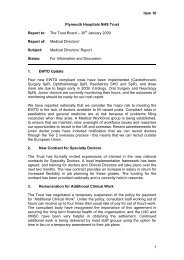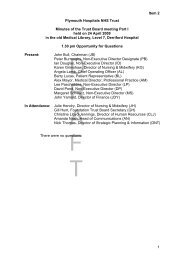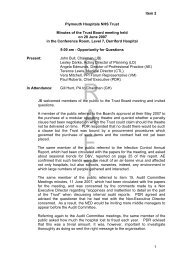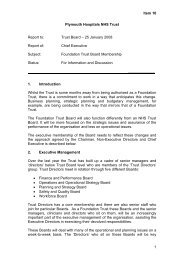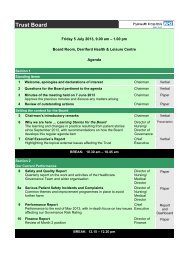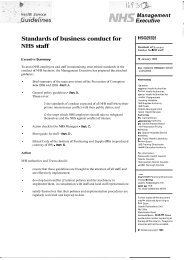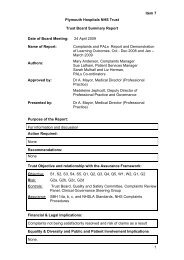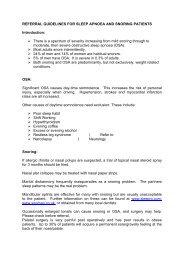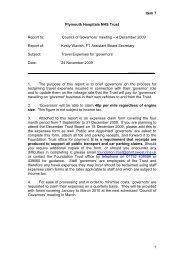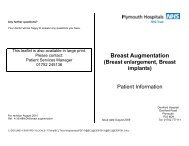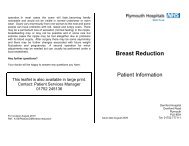PHT Public Trust Board Papers March 2011.pdf - Plymouth Hospitals
PHT Public Trust Board Papers March 2011.pdf - Plymouth Hospitals
PHT Public Trust Board Papers March 2011.pdf - Plymouth Hospitals
Create successful ePaper yourself
Turn your PDF publications into a flip-book with our unique Google optimized e-Paper software.
Item 7<br />
Priority 2 - Appropriate handover and escalation during patient management<br />
Identification of the deteriorating patient and ensuring appropriate escalation and response is<br />
an essential aspect of patient care. The <strong>Trust</strong> has developed an action plan to improve the<br />
care of deteriorating patients and reduce the number of cardiac arrests, which includes a<br />
colour banded observation chart for the early detection and appropriate escalation of unwell<br />
patients.<br />
How will we do it?<br />
The <strong>Trust</strong> has developed an action plan to improve the care of deteriorating patients and<br />
reduce the number of cardiac arrests, which includes a colour banded observation chart for<br />
the early detection and appropriate escalation of unwell patients. Patients that trigger on the<br />
observation chart will be added to the ward whiteboard and discussed at the daily safety<br />
briefing which have been introduced to ensure structured handover of key patient information<br />
including key principles Situation, Background, Assessment and Recommendation (SBAR).<br />
All cardiac arrests calls will be investigated to identify aspects of care which may have<br />
attributed to preventable deterioration.<br />
We will ensure that patient observations are carried out in a timely manner and that all<br />
deteriorating patients are appropriately escalated to ensure action is taken.<br />
How will we measure it?<br />
The percentage of patient who trigger on the Early Warning System and receive an<br />
appropriate response will be monitored monthly, alongside the number of rapid response<br />
calls made per month. These figures will provide assurance that when a patient deteriorates<br />
appropriate escalation has taken place.<br />
We will monitor the frequency and percentage of wards using daily safety briefings, to assess<br />
the communication methods used to handover patient information.<br />
The number of cardiac arrest calls will be monitored monthly to ascertain how many were<br />
avoidable. In addition the <strong>Trust</strong> subscribes to the Dr Foster mortality database, which<br />
predicts the Hospital Standardised Mortality Ratio (HSMR) which is an indicator of healthcare<br />
quality that measures whether the death rate at a hospital is higher or lower than you would<br />
expect.<br />
% reduction in the number of cardiac arrest calls<br />
% increase in the number of rapid response calls<br />
Increase the % of patients who trigged on the EWS and receive an appropriate response<br />
Increase the frequency and percentage of wards using daily safety briefings<br />
% to be confirmed<br />
How will we report it?<br />
Regular monthly reports will be submitted to the Clinical Governance Steering Group and<br />
quarterly reports submitted to the <strong>Trust</strong>’s Safety & Quality Committee. Additional monthly<br />
reports on progress will be submitted to the SHA.<br />
Priority 3 - Ensure effective pathways of patient care across the health community,<br />
appropriate follow up, continuity of clinical care, reducing length of stay and reducing<br />
delayed discharges<br />
As a Health Community there is a requirement to make efficiencies throughout elective care,<br />
in order to improve both the patient experience and to reduce costs.<br />
Sarah Widnell / Jayne Glynn V7 21.03.11 5



